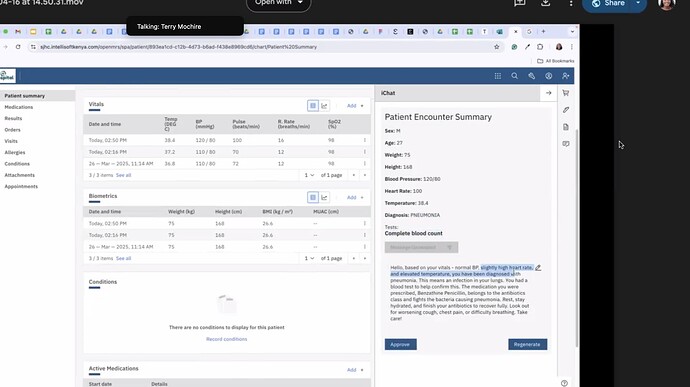Hello OpenMRS Community! ![]()
At @Intellisoft we are exploring ways to improve patient education and health literacy using AI within OpenMRS-based systems. Many times patients leave clinical visits without fully understanding their diagnosis, treatment plans, or next steps—leading to poor adherence to prescribed treatment plans and poor health outcomes.
Project Overview
We have developed an AI-Powered Patient Education Module that integrates with OpenMRS to generate personalised, easy-to-understand clinical summaries for patients after their consultation. The process follows this workflow:
- Clinician records encounter details in OpenMRS (diagnosis, treatment plan, lab results).
- The clinician provides the patient with a physical consent form, explaining the purpose of the AI-generated health summary and obtaining their written consent.
- Patient reviews and signs the consent form if they agree to receive an AI-generated summary.
- If consent is granted, the clinician logs the consent in OpenMRS and proceeds with sending encounter details to the LLM.
- If the patient declines to consent, the clinician records the reason, and the AI summary is not generated.
- For consenting patients, encounter details are sent to the LLM, which generates a patient-friendly health summary in simple language.
- The clinician reviews and approves the AI-generated message before sharing it with the patient. If edits or revisions are needed, the clinician provides input.
- The approved summary is delivered via SMS (plan to expand this to email or WhatsApp)
- Visit is closed, and the patient leaves with a clear, personalized health summary to support treatment adherence and understanding.
Key Benefits
- Improves patient understanding & adherence to treatment plans.
- Reduces the clinician’s burden by automating patient education.
- Integrates seamlessly with OpenMRS to enhance usability in real-world settings.
Seeking Community Feedback
We are in the process of testing and refining this approach and would love to hear your thoughts! Specifically, we would appreciate feedback on:
- Handling patient consent within OpenMRS-based implementations.
- Other use cases where patient education automation could be most impactful.
- Any interest from other implementers in piloting this feature in OpenMRS deployments.
We welcome any questions, insights, or suggestions from the community. Let’s collaborate to enhance patient-centred care using AI!
Looking forward to your thoughts. ![]()


